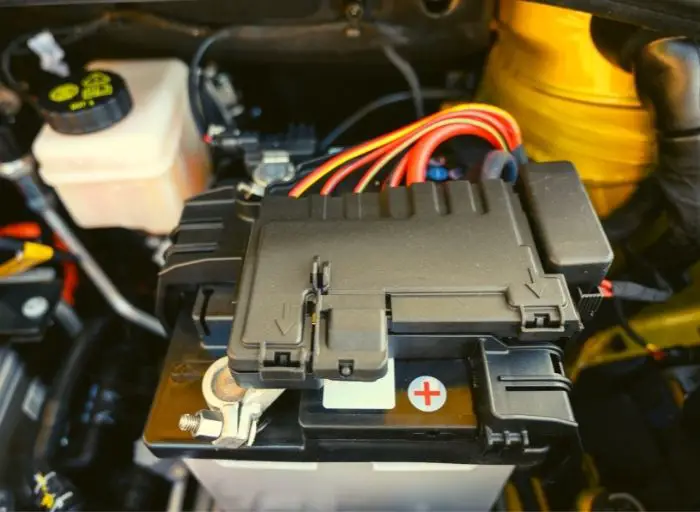
Due to excessive current flow produced by internal malfunctioning problems like a short circuit, the fusible link or primary alternator fuse can go bad or blow out. But do you know how to spot bad fusible link symptoms?
Simply said, when you have problems controlling the automatic windows and central lock, this is the most evident symptom that you may have a faulty fusible link.
Table of Contents
Fusible Link Overview
What Is A Fusible Link, and What is it Used For?
A fusible link is a specially designed safety device that protects electrical circuits from overloading and short circuits. It consists of a wire designed to melt when exposed to excessive heat caused by an electrical overload in the circuit. Essentially, a fusible link is a type of fuse directly integrated into a circuit’s wiring.

Fusible linkages are usually near the car battery, where they can protect the whole electrical system.
Sometimes, you could find more fusible connections in other electrical system parts, such as next to the alternator or starting motor. These extra connections offer protection for particular electrical system circuits.
The particular conductor used to create fusible linkages has a high melting point. This conductor is usually constructed of copper or aluminum.
The battery’s positive terminal is linked to one end of the fusible link, which has two ends, and an electrical system component that has to be protected is attached to the other end.
Very little current passes through the fusible link when everything is operating as it should. However, the electrical system will experience issues like a short circuit, which will increase the current passing through the fusible link.
Fusible links “blow” or melt when the current passing through them reaches a specific threshold. As a result, the circuit is broken, protecting the car’s electrical system from further harm.
Fusible connections are critical parts of modern vehicles’ safety systems. Either they can protect the entire electrical system, or only certain circuits can be protected.
How does a fusible link work?
The operation of a fusible link is simple yet effective. Whenever an electrical circuit experiences a short circuit or overload, the circuit’s current flow increases drastically, leading to a build-up of heat.
When the temperature in the circuit reaches a certain threshold, the fusible link wire starts to melt, creating a break in the circuit and therefore stopping the current flow.
This breakage in the circuit prevents more significant damage to the system and ensures that the electrical circuit is safe.
Fusible Links Color Codes for Amperage

Fusible links have various colors to signify their amperage ratings, similar to fuses. Various colors may be chosen depending on the vehicle. However, the most prevalent hues are blue, green, red, orange, black, and brown.
The average amps for different fusible link colors are:
- Red fusible links: 20 amps
- Green fusible links: 16 amps
- Yellow fusible links: 23 amps
- Black fusible links: 26 amps
- Brown fusible links: 33 amps
- Blue fusible links: 35 amps
Where Can I Find Fusible Links in My Car?

So where in your car can you locate a fusible link? These flammable connections are typically found between delicate harnesses and powerful energy sources. As a result, a fusible link between the battery and the alternator is to be expected.
The battery fusible link is intended to convey strong electrical currents while safeguarding the vehicle’s wire harness.
Bad Fusible Link Symptoms
1. Can’t use the automatic window and central lock options

The first symptom is when you realize that you cannot automatically operate open and close car windows.
You can also notice that the option for automatic central locking is disabled. You will have to manually lock and unlock the windows and central lock instead of using the automatic option.
2. Music and radio failure

The majority of individuals listen to the radio for news or like listening to music while driving. However, if your fusible link fails, you won’t be able to listen to music or tune in to the radio while driving.
Even though the radio or music player is turned on, you may not be likely to hear the sound well, or the music may be interrupted frequently.
3. Issues with wipers
When the vehicle wipers refuse to act or work, this is another common symptom of a blown or damaged fusible link. Wipers are designed to keep the vision in front of you clear so you can stay on the road safe and sound.
However, if your fusible link fails, the wipers will stop working, keeping your eyesight sharper on rainy or snowy days.
4. Lighting & electrical issues
Electronics that rely on charging system voltage are found in today’s modern and computer-controlled vehicles.
On the other hand, a blown, fractured, or damaged fusible link inhibits the vehicle’s charging system from functioning properly and causes serious electrical problems, particularly in computer-controlled automobiles.
As a result, car lights fade, such as headlights or warning lights.
Check the condition of your fusible link and replace it if any of the dashboard warning lights come on or other vehicle lights dim.
5. Failure of the battery

Because the fusible link is crucial for charging the vehicle’s internal battery, it will suffer from inadequate charge if it becomes damaged or bad. It could be another sign that the existing fusible link must be replaced.
When a fusible link blows, it cannot charge the battery. In this case, your vehicle may experience starting or operating troubles due to battery failure.
Methods For Testing Fusible Links
A damaged alternator or a bad battery connection can also bring on the aforementioned signs. Therefore, it’s crucial to make sure the fusible link is the issue before replacing it.
Using a multimeter
A multimeter is the most effective tool for testing a fusible link.
Examine the negative battery plug first.
Place the multimeter’s red outlet anyplace on the car’s body and the black outlet on the negative battery terminal.
On the multimeter, you ought to receive a reading. This demonstrates that both the battery and its plug are in good condition.
Next, check the alternator cable using the multimeter.

If you can read, that suggests the alternator is also working well. The fusible link is left after this.
So how do you use a multimeter to test a fusible link? Put the red inspection rod on the fusible link using a multimeter.
The fusible link will typically have the phrase “fusible links” on it and will be thinner than the other wires and feel rubbery. Look for physical damage to this wire. A ruptured fusible connection will result in obvious physical harm.
Check the key in the ignition
While the key is in the ignition, you can also test the fusible link by gently wiggling it. If that’s the issue, you’ll see that when you do this, the speedometer stops jumping.
How to Replace Fusible Links?
The first thing you should do is inspect or diagnose the fusible link.
Diagnosis of a bad fusible link
This is a straightforward procedure. You must first go beneath the hood. After that, you must locate the battery. Typically, the fusible link is located near the battery. Look for a wire that is about two gauges smaller than the other harnesses. You may notice that the wire is far more stretchy than the other wires when you touch it.
The cable may even have the words “fusible link” printed on it. It’s as simple as pie if you can locate the text. After you’ve located the fusible link, keep an eye out for any wire damage or blows. Then you’ll understand what happened.
Instructions for replacing fusible links
You’re ready to go after the examination and identification. Now you must complete the following steps:
- To begin, remove the blown fusible link.
- Second, replace the old fusible link with the new one.
- Finally, ensure you’re using the proper fusible link with more resistance than the wiring.
It’s tempting to utilize a fuse rather than a fusible link. However, you shouldn’t do so. The fusible linkages were created for a reason. In this aspect, you must have faith in them. Because if it were okay, they’d utilize fuses instead of fusible linkages, to begin with.
How Much Does It Cost To Change Fusible Links?
A fusible link is often inexpensive to replace. Fusible links are inexpensive, running approximately $3. You may replace the fusible link yourself, and the procedure is not difficult.
FAQs
1. Can a fusible link be replaced with a fuse?
Yes, technically. Fusible links can be replaced with fuses. However, this is not a smart idea. The fusible connections were installed in the automobiles by the vehicle engineers for a reason. Fusible links have a smaller structure and can handle far more current than standard fuses. However, if the job is urgent or you insist on doing it anyhow, we recommend utilizing mega fuses.
2. How long are the fusible links?
A fusible link, on the other hand, has no set length. The length is determined by the conductor’s wire diameter. The fusible link wire size is usually four gauges smaller than the original conductor. Furthermore, fusible linkages that are longer than 12″ should not be used.
3. Will the car start if the fusible link is bad?
Fusible links can be difficult to diagnose and repair since their deterioration is sometimes difficult to identify with a visual inspection. Furthermore, because they’re made to deal with high-current electrical parts, they frequently result in a no-start problem when they fail.
4. What causes a fusible link to burnout?
When a circuit tries to send too much current, a fuse will often blow, cutting the link well before the electrical charge can cause any harm. The connection melts when there’s a surge because its heat resistance is lower than the circuits it’s safeguarding.
Check out this video for How to Replace a Fusible Link (Car won’t Start)
Although a fusible link may appear to be a small piece of wire, it plays an important role in keeping your vehicle’s electrical parts active and safe. Fusible links are responsible for sustaining interior electric flow and avoiding current overflow damage.
That is why you must have the fusible link up to date, and the signs listed above will alert you when it is time to check on the fusible link.
Further reading:
Hi there! I’m Naomi O’Colman. I’ve got years of experience working at an auto repair shop here in Texas under my belt. On top of that, ever since I was a kid I’ve been passionate about the auto industry. Since I’ve joined the team at automotivegearz.com I’ve been enthusiastically sharing my passion and insights with my readers. I’m dedicated to delivering high quality content and helping you stay up to date with the latest automotive trends and products out there!







